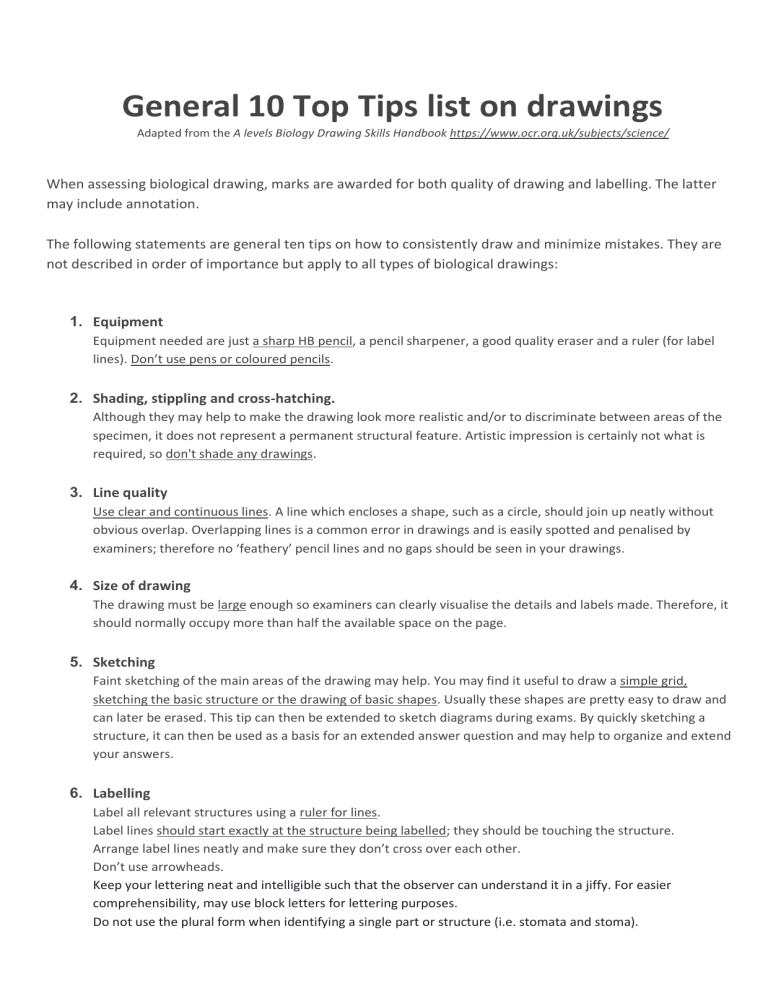Biology Drawing Tips: A Guide to Accurate Scientific Drawings
advertisement

General 10 Top Tips list on drawings Adapted from the A levels Biology Drawing Skills Handbook https://www.ocr.org.uk/subjects/science/ When assessing biological drawing, marks are awarded for both quality of drawing and labelling. The latter may include annotation. The following statements are general ten tips on how to consistently draw and minimize mistakes. They are not described in order of importance but apply to all types of biological drawings: 1. Equipment Equipment needed are just a sharp HB pencil, a pencil sharpener, a good quality eraser and a ruler (for label lines). Don’t use pens or coloured pencils. 2. Shading, stippling and cross-hatching. Although they may help to make the drawing look more realistic and/or to discriminate between areas of the specimen, it does not represent a permanent structural feature. Artistic impression is certainly not what is required, so don't shade any drawings. 3. Line quality Use clear and continuous lines. A line which encloses a shape, such as a circle, should join up neatly without obvious overlap. Overlapping lines is a common error in drawings and is easily spotted and penalised by examiners; therefore no ‘feathery’ pencil lines and no gaps should be seen in your drawings. 4. Size of drawing The drawing must be large enough so examiners can clearly visualise the details and labels made. Therefore, it should normally occupy more than half the available space on the page. 5. Sketching Faint sketching of the main areas of the drawing may help. You may find it useful to draw a simple grid, sketching the basic structure or the drawing of basic shapes. Usually these shapes are pretty easy to draw and can later be erased. This tip can then be extended to sketch diagrams during exams. By quickly sketching a structure, it can then be used as a basis for an extended answer question and may help to organize and extend your answers. 6. Labelling Label all relevant structures using a ruler for lines. Label lines should start exactly at the structure being labelled; they should be touching the structure. Arrange label lines neatly and make sure they don’t cross over each other. Don’t use arrowheads. Keep your lettering neat and intelligible such that the observer can understand it in a jiffy. For easier comprehensibility, may use block letters for lettering purposes. Do not use the plural form when identifying a single part or structure (i.e. stomata and stoma). 7. Annotating Annotation adds concise notes about the structures labelled on a biological drawing. It is often used to draw attention to features of particular biological interest, either structural (such as shape, size, colour, hairiness) or functional. 8. Accuracy Accurate attention to detail is encouraged. Ensure the proportions are correct, i.e. different areas are the right size relative to each other, and that your drawing is a true likeness of the specimen that you are drawing. Therefore, check your drawings to see if all criteria are included. If you make a mistake, use a good quality eraser to rub it out. 9. Dimension Draw 2D diagrams instead of 3D as they are flat and easier to draw. 10. Practice This is the best tip that there is. You must practice each diagram many times until you can draw it with no mistakes. Repetition is key to developing drawing skills as it improves your muscle memory.





